Closed-Loop Feedback Computation Model of Dynamical Reputation Based on the Local Trust Evaluation in Business-to-Consumer E-Commerce
Abstract
:1. Introduction
2. Related Works
2.1. Trust-Related Research in Pervasive Networks
2.2. Trust Research Approaches in E-Commerce
2.3. Trust-Related Computation Methods in E-Commerce
2.4. Probability Methods in Trust Computation
3. Relationship of Trust and Reputation
3.1. Meanings of Trust
3.2. Components of Trust

| Trustor | Consumer | Disposition to trust, purchase history ,attitude towards online shopping, attitude towards information technique, personal values, age, education and gender, subjective perceptive risk |
| Trustee | Online firm | Brand, reputation, offline presence, predictability, dependence, faith, cooperation, familiarity, benevolence, history of the firm |
| Merchant | Quality, satisfaction, price, service, transference, familiarity | |
| Website | Likeability, convenience, usability, efficiency, reliability, portability, integrity, privacy, security, branding | |
| Circumstance | Technique | Privacy, security, transparency, credibility of information, characteristics of computer technique, Internet technique, information technique, encryption, third-party certification |
| Society | General attitude towards trust, Internet and e-commerce, policy, law, morality, culture |
3.3. Hierarchical Structure of Online Trust
| Total Trust | Objective Trust | Institutional Trust | Situation norm | C1-C6, D3, E6-E7 |
| Structure guarantee | A8, C7-C9, D5, E1-E4, E8 | |||
| Subjective Trust | Direct Trust | Direct perceived trust | A1-A8, B1-B4, C1-C9, D1-D5, E1-E8 | |
| Individual recommendation | A1, A7 | |||
| Indirect Trust | reputation | A1, A3, A8, B2, C1, D1 |
3.4. Logical Relationship between Trust and Reputation
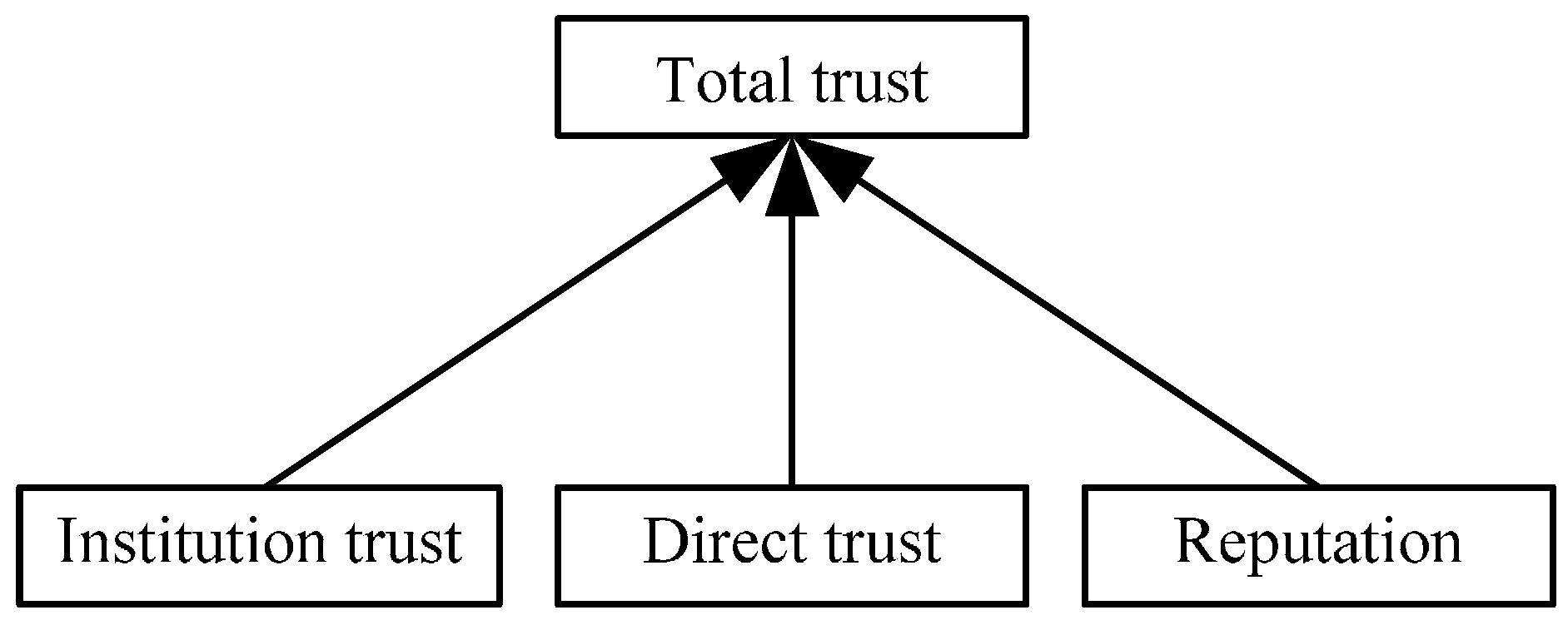
4. The Proposed Model
4.1. Variables in the Model
| Dimension | Dangdang | Amazon | Trust-Related Factors |
|---|---|---|---|
| Quality | Content is good | Quality is fine | B1–B2,B4,C1,D1–D3 |
| Price | Price is reasonable | It is expensive, comparatively | B3 |
| Logistics | Logistics are slow | Logistics are very fast | E2–E3,D1–D4 |
| Servers | I connect to servers easily | Relative information is useful | A1–A4,B4,C1–C5,D1–D4,E4–E7 |
4.2. Iterative Model of Reputation and Trust
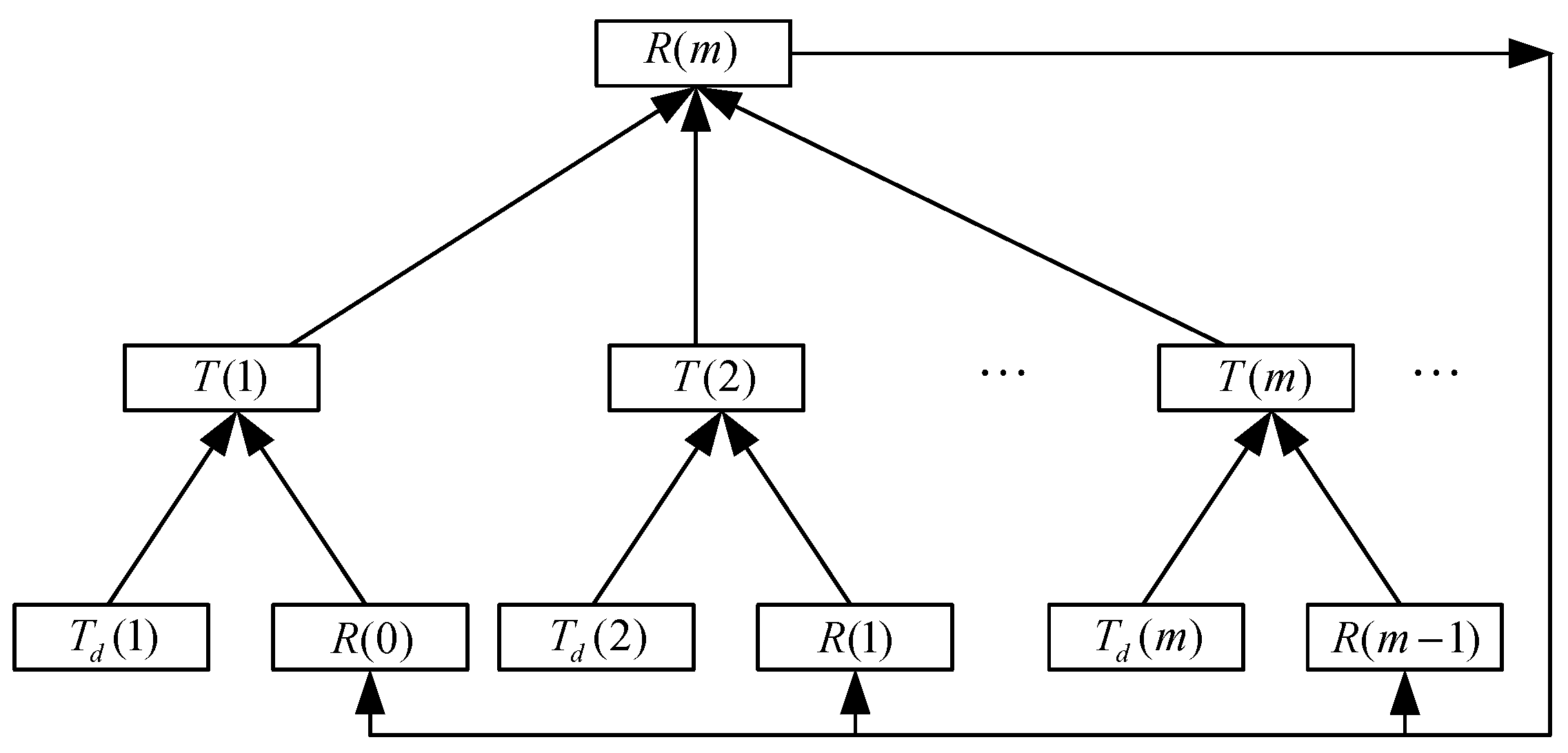
4.3. Computation of Direct Trust
4.3.1. Characteristics of Beta Distribution
| Total | |||||
|---|---|---|---|---|---|
| 6 | 2 | 4 | 0.375 | 0.0260 | 0.9740 |
| 14 | 5 | 9 | 0.375 | 0.0138 | 0.9862 |
| 22 | 8 | 14 | 0.375 | 0.0094 | 0.9906 |
| 30 | 11 | 19 | 0.375 | 0.0071 | 0.9929 |
| 38 | 14 | 24 | 0.375 | 0.0057 | 0.9943 |
| 46 | 17 | 29 | 0.375 | 0.0048 | 0.9952 |
| 54 | 20 | 34 | 0.375 | 0.0041 | 0.9959 |
| 62 | 23 | 39 | 0.375 | 0.0036 | 0.9964 |
| 70 | 26 | 44 | 0.375 | 0.0032 | 0.9968 |
| 78 | 29 | 49 | 0.375 | 0.0029 | 0.9971 |
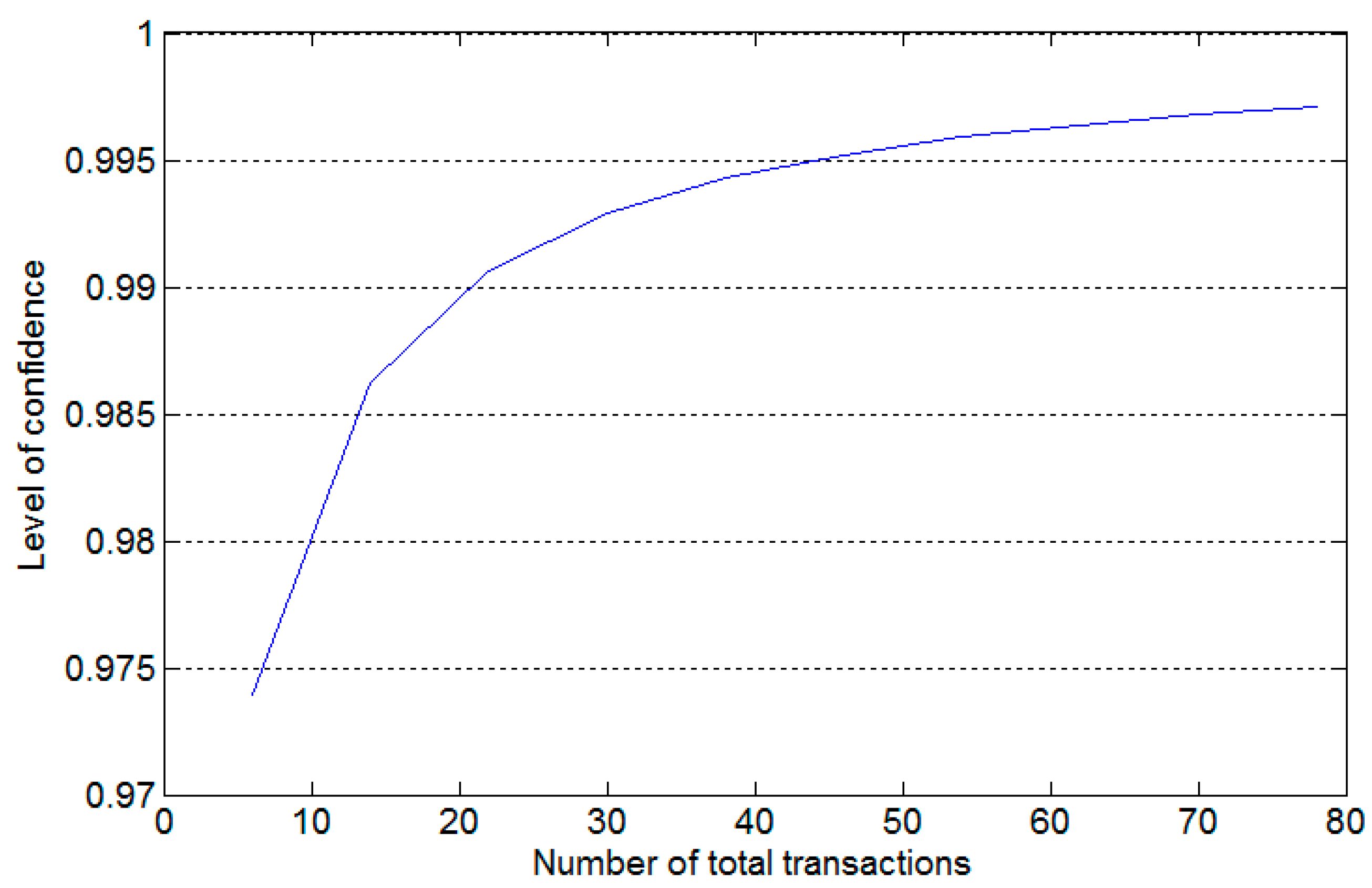
4.3.2. Multi-Dimensional Beta Distribution
4.3.3. Dynamical Reputation Computation Processes
5. Experimental Results
5.1. Data Collection
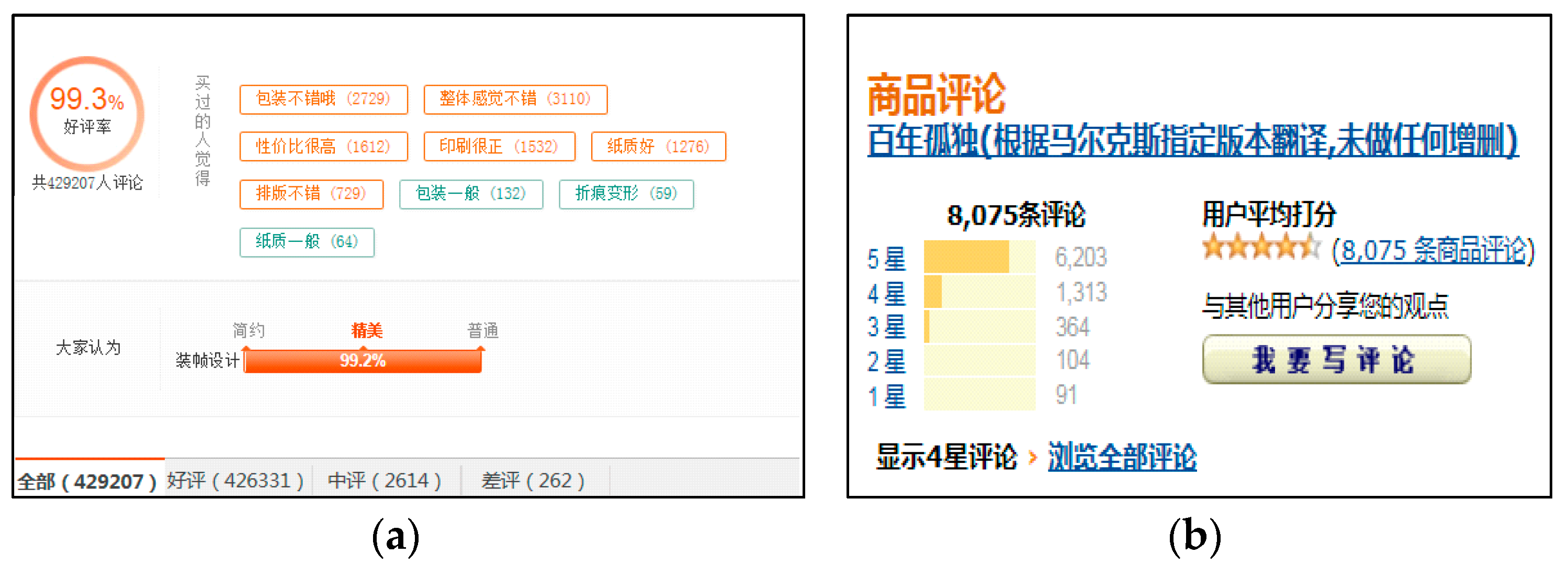
5.2. Computation Results
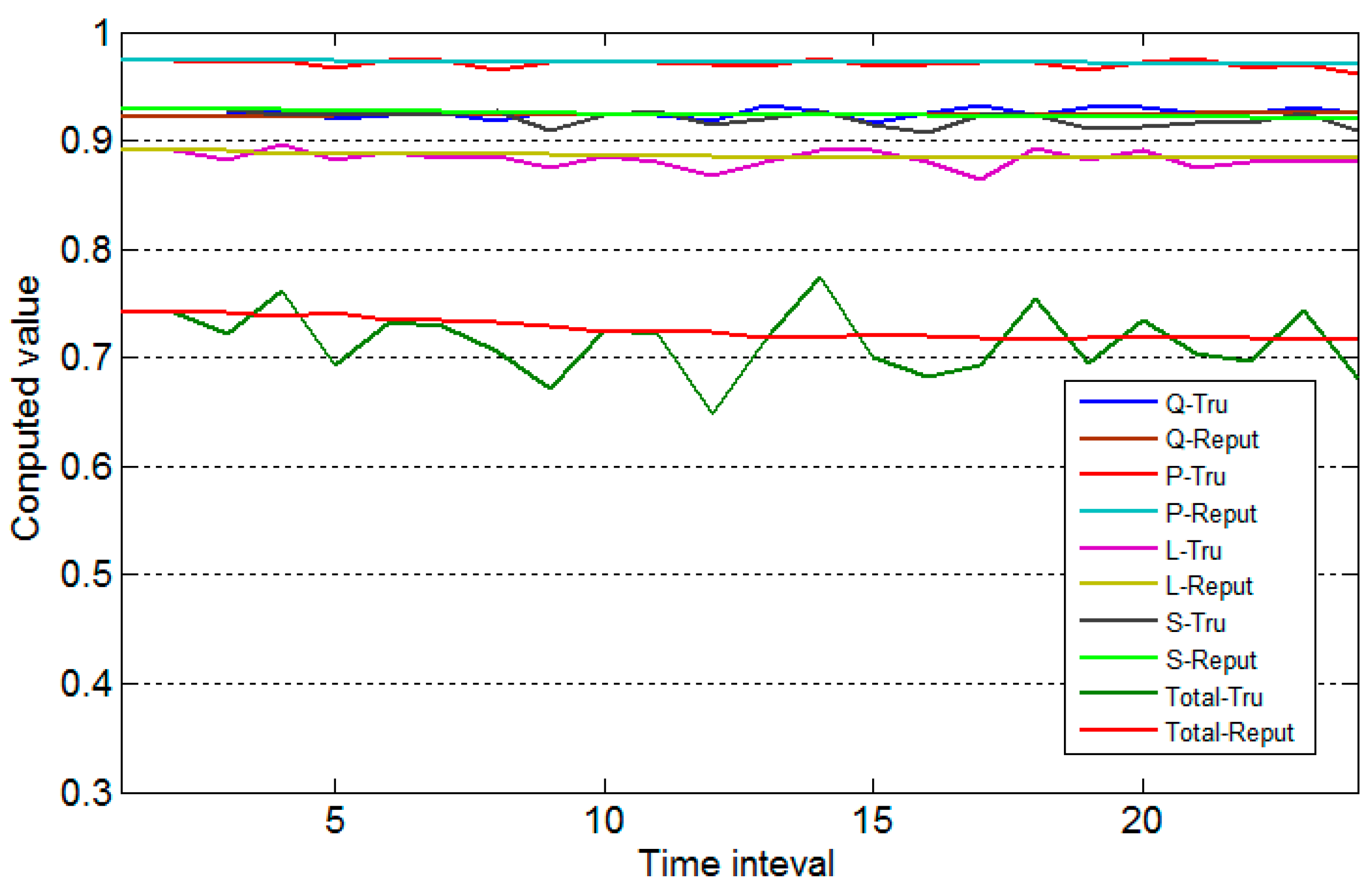
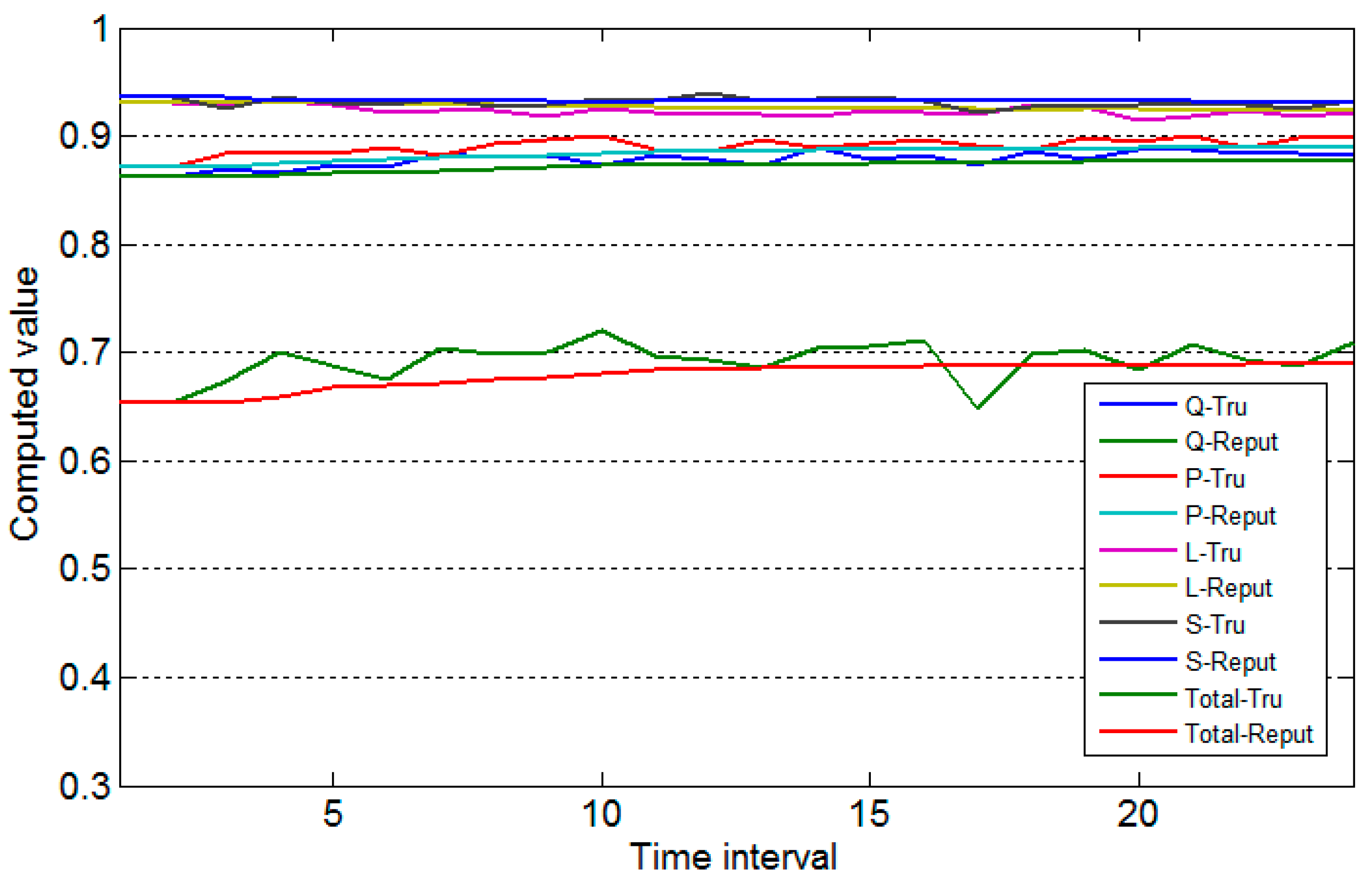
| Time Interval | Number of Evaluations of Dangdang | Number of Evaluations of Amazon | ||||||||||||||
|---|---|---|---|---|---|---|---|---|---|---|---|---|---|---|---|---|
| Quality | Price | Logistics | Servers | Quality | Price | Logistics | Servers | |||||||||
| + | − | + | − | + | − | + | − | + | − | + | − | + | − | + | − | |
| 2013.06 | 223 | 18 | 324 | 08 | 285 | 34 | 327 | 24 | 24 | 3 | 26 | 3 | 26 | 1 | 28 | 1 |
| 2013.07 | 353 | 25 | 285 | 07 | 149 | 27 | 261 | 19 | 35 | 3 | 42 | 2 | 33 | 2 | 23 | 2 |
| 2013.08 | 395 | 17 | 427 | 09 | 392 | 35 | 298 | 31 | 22 | 2 | 29 | 1 | 47 | 2 | 44 | 2 |
| 2013.09 | 264 | 26 | 250 | 14 | 264 | 42 | 235 | 25 | 46 | 4 | 42 | 3 | 46 | 3 | 37 | 2 |
| 2013.10 | 354 | 29 | 418 | 11 | 317 | 39 | 173 | 16 | 35 | 3 | 43 | 2 | 37 | 4 | 41 | 3 |
| 2013.11 | 469 | 30 | 367 | 07 | 185 | 28 | 372 | 35 | 41 | 1 | 35 | 3 | 25 | 2 | 32 | 1 |
| 2013.12 | 358 | 41 | 294 | 18 | 378 | 52 | 264 | 19 | 64 | 4 | 52 | 2 | 53 | 5 | 37 | 3 |
| 2014.01 | 596 | 47 | 425 | 03 | 421 | 87 | 287 | 55 | 39 | 2 | 47 | 1 | 71 | 9 | 52 | 4 |
| 2014.02 | 397 | 32 | 358 | 10 | 258 | 34 | 232 | 21 | 22 | 2 | 39 | 0 | 45 | 3 | 32 | 1 |
| 2014.03 | 286 | 23 | 261 | 06 | 274 | 46 | 359 | 23 | 47 | 3 | 28 | 2 | 27 | 2 | 45 | 2 |
| 2014.04 | 243 | 28 | 174 | 05 | 152 | 39 | 285 | 41 | 35 | 3 | 31 | 3 | 34 | 3 | 37 | 0 |
| 2014.05 | 378 | 11 | 282 | 12 | 250 | 41 | 252 | 28 | 34 | 4 | 42 | 2 | 33 | 3 | 29 | 1 |
| 2014.06 | 412 | 25 | 467 | 02 | 376 | 32 | 274 | 15 | 53 | 2 | 37 | 3 | 38 | 4 | 48 | 2 |
| 2014.07 | 258 | 32 | 365 | 15 | 311 | 27 | 327 | 43 | 26 | 2 | 54 | 4 | 45 | 3 | 35 | 1 |
| 2014.08 | 395 | 28 | 391 | 12 | 285 | 43 | 163 | 30 | 41 | 3 | 40 | 2 | 31 | 2 | 42 | 2 |
| 2014.09 | 406 | 13 | 226 | 05 | 128 | 36 | 270 | 22 | 30 | 4 | 29 | 2 | 36 | 3 | 21 | 2 |
| 2014.10 | 378 | 29 | 362 | 08 | 380 | 29 | 361 | 27 | 51 | 3 | 30 | 3 | 57 | 2 | 36 | 3 |
| 2014.11 | 312 | 14 | 254 | 16 | 294 | 41 | 235 | 35 | 48 | 5 | 43 | 2 | 65 | 3 | 28 | 2 |
| 2014.12 | 659 | 31 | 258 | 05 | 459 | 40 | 196 | 28 | 39 | 2 | 58 | 4 | 46 | 6 | 31 | 2 |
| 2015.01 | 875 | 69 | 467 | 01 | 396 | 74 | 452 | 51 | 52 | 3 | 69 | 3 | 72 | 8 | 80 | 6 |
| 2015.02 | 457 | 32 | 357 | 19 | 238 | 37 | 239 | 27 | 21 | 1 | 32 | 3 | 47 | 3 | 34 | 2 |
| 2015.03 | 485 | 21 | 274 | 08 | 165 | 24 | 368 | 21 | 30 | 2 | 54 | 3 | 25 | 2 | 27 | 2 |
| 2015.04 | 266 | 19 | 187 | 14 | 271 | 36 | 227 | 35 | 27 | 2 | 41 | 2 | 42 | 3 | 43 | 2 |
| 2015.05 | 425 | 28 | 382 | 09 | 318 | 33 | 185 | 26 | 42 | 3 | 48 | 3 | 39 | 2 | 27 | 1 |
| Time Interval | Q-Tru. | Q-Reput. | P-Tru. | P-Reput. | L-Tru. | L-Reput. | S-Tru | S-Reput. | Total-Tru | Total-Reput | |
|---|---|---|---|---|---|---|---|---|---|---|---|
| 2013.06 | 0.9218 | 0.9218 | 0.9731 | 0.9731 | 0.8910 | 0.8910 | 0.9292 | 0.9292 | 0.7426 | 0.7426 | 0.99943 |
| 2013.07 | 0.9218 | 0.9218 | 0.9731 | 0.9731 | 0.8910 | 0.8910 | 0.9292 | 0.9292 | 0.7426 | 0.7426 | 0.99919 |
| 2013.08 | 0.9238 | 0.9218 | 0.9730 | 0.9731 | 0.8813 | 0.8910 | 0.9292 | 0.9292 | 0.7227 | 0.7426 | 0.99958 |
| 2013.09 | 0.9288 | 0.9225 | 0.9739 | 0.9730 | 0.8960 | 0.8877 | 0.9240 | 0.9292 | 0.7611 | 0.7376 | 0.99933 |
| 2013.10 | 0.9195 | 0.9240 | 0.9672 | 0.9732 | 0.8823 | 0.8898 | 0.9235 | 0.9279 | 0.6933 | 0.7423 | 0.99939 |
| 2013.11 | 0.9236 | 0.9231 | 0.9730 | 0.9720 | 0.8895 | 0.8883 | 0.9245 | 0.9270 | 0.7322 | 0.7341 | 0.99939 |
| 2013.12 | 0.9261 | 0.9232 | 0.9734 | 0.9722 | 0.8837 | 0.8885 | 0.9240 | 0.9266 | 0.7283 | 0.7339 | 0.99949 |
| 2014.01 | 0.9176 | 0.9236 | 0.9657 | 0.9724 | 0.8863 | 0.8878 | 0.9272 | 0.9262 | 0.7052 | 0.7332 | 0.99954 |
| 2014.02 | 0.9269 | 0.9229 | 0.9715 | 0.9715 | 0.8757 | 0.8876 | 0.9084 | 0.9263 | 0.6716 | 0.7301 | 0.99942 |
| 2014.03 | 0.9230 | 0.9233 | 0.9713 | 0.9715 | 0.8863 | 0.8863 | 0.9238 | 0.9244 | 0.7248 | 0.7242 | 0.99944 |
| 2014.04 | 0.9232 | 0.9233 | 0.9720 | 0.9715 | 0.8798 | 0.8863 | 0.9270 | 0.9243 | 0.7215 | 0.7243 | 0.99913 |
| 2014.05 | 0.9174 | 0.9233 | 0.9706 | 0.9715 | 0.8676 | 0.8857 | 0.9138 | 0.9245 | 0.6481 | 0.7240 | 0.99938 |
| 2014.06 | 0.9325 | 0.9228 | 0.9685 | 0.9715 | 0.8799 | 0.8842 | 0.9191 | 0.9236 | 0.7170 | 0.7182 | 0.99962 |
| 2014.07 | 0.9264 | 0.9235 | 0.9759 | 0.9712 | 0.8913 | 0.8839 | 0.9279 | 0.9233 | 0.7746 | 0.7181 | 0.99944 |
| 2014.08 | 0.9162 | 0.9237 | 0.9686 | 0.9716 | 0.8906 | 0.8844 | 0.9150 | 0.9236 | 0.6998 | 0.7219 | 0.99927 |
| 2014.09 | 0.9253 | 0.9232 | 0.9708 | 0.9714 | 0.8809 | 0.8848 | 0.9071 | 0.9231 | 0.6832 | 0.7205 | 0.99899 |
| 2014.10 | 0.9319 | 0.9234 | 0.9719 | 0.9713 | 0.8633 | 0.8846 | 0.9228 | 0.9221 | 0.6930 | 0.7183 | 0.99960 |
| 2014.11 | 0.9240 | 0.9239 | 0.9722 | 0.9714 | 0.8931 | 0.8833 | 0.9233 | 0.9221 | 0.7541 | 0.7169 | 0.99936 |
| 2014.12 | 0.9300 | 0.9239 | 0.9646 | 0.9714 | 0.8817 | 0.8839 | 0.9112 | 0.9222 | 0.6944 | 0.7188 | 0.99945 |
| 2015.01 | 0.9299 | 0.9242 | 0.9726 | 0.9711 | 0.8907 | 0.8837 | 0.9121 | 0.9216 | 0.7352 | 0.7176 | 0.99965 |
| 2015.02 | 0.9246 | 0.9245 | 0.9760 | 0.9711 | 0.8752 | 0.8841 | 0.9167 | 0.9211 | 0.7045 | 0.7185 | 0.99939 |
| 2015.03 | 0.9261 | 0.9245 | 0.9663 | 0.9714 | 0.8798 | 0.8837 | 0.9160 | 0.9209 | 0.6969 | 0.7178 | 0.99934 |
| 2015.04 | 0.9309 | 0.9246 | 0.9708 | 0.9711 | 0.8808 | 0.8835 | 0.9255 | 0.9207 | 0.7430 | 0.7169 | 0.99927 |
| 2015.05 | 0.9257 | 0.9248 | 0.9621 | 0.9711 | 0.8828 | 0.8834 | 0.9093 | 0.9209 | 0.6798 | 0.7180 | 0.99938 |
| Time Interval | Q-Tru. | Q-Reput. | P-Tru. | P-Reput. | L-Tru. | L-Reput. | S-Tru | S-Reput. | Total-Tru | Total-Reput | |
|---|---|---|---|---|---|---|---|---|---|---|---|
| 2013.06 | 0.8621 | 0.8621 | 0.8710 | 0.8710 | 0.9310 | 0.9310 | 0.9355 | 0.9355 | 0.6540 | 0.6540 | 0.99372 |
| 2013.07 | 0.8621 | 0.8621 | 0.8710 | 0.8710 | 0.9310 | 0.9310 | 0.9355 | 0.9355 | 0.6540 | 0.6540 | 0.99479 |
| 2013.08 | 0.8697 | 0.8621 | 0.8837 | 0.8710 | 0.9286 | 0.9310 | 0.9262 | 0.9355 | 0.6739 | 0.6540 | 0.99494 |
| 2013.09 | 0.8666 | 0.8646 | 0.8843 | 0.8752 | 0.9331 | 0.9302 | 0.9359 | 0.9324 | 0.7006 | 0.6589 | 0.99626 |
| 2013.10 | 0.8724 | 0.8651 | 0.8832 | 0.8775 | 0.9285 | 0.9309 | 0.9313 | 0.9333 | 0.6874 | 0.6673 | 0.99575 |
| 2013.11 | 0.8721 | 0.8666 | 0.8892 | 0.8786 | 0.9215 | 0.9304 | 0.9292 | 0.9329 | 0.6748 | 0.6706 | 0.99508 |
| 2013.12 | 0.8842 | 0.8675 | 0.8829 | 0.8804 | 0.9237 | 0.9290 | 0.9349 | 0.9323 | 0.7040 | 0.6712 | 0.99674 |
| 2014.01 | 0.8797 | 0.8699 | 0.8936 | 0.8807 | 0.9232 | 0.9282 | 0.9268 | 0.9326 | 0.6979 | 0.6753 | 0.99701 |
| 2014.02 | 0.8819 | 0.8711 | 0.8966 | 0.8824 | 0.9182 | 0.9276 | 0.9289 | 0.9319 | 0.7000 | 0.6778 | 0.99504 |
| 2014.03 | 0.8738 | 0.8723 | 0.9010 | 0.8839 | 0.9261 | 0.9265 | 0.9341 | 0.9316 | 0.7203 | 0.6800 | 0.99527 |
| 2014.04 | 0.8825 | 0.8724 | 0.8884 | 0.8856 | 0.9219 | 0.9265 | 0.9330 | 0.9318 | 0.6976 | 0.6837 | 0.99528 |
| 2014.05 | 0.8780 | 0.8734 | 0.8863 | 0.8859 | 0.9207 | 0.9261 | 0.9403 | 0.9319 | 0.6932 | 0.6849 | 0.99527 |
| 2014.06 | 0.8737 | 0.8737 | 0.8957 | 0.8859 | 0.9198 | 0.9256 | 0.9330 | 0.9326 | 0.6856 | 0.6855 | 0.99619 |
| 2014.07 | 0.8885 | 0.8737 | 0.8897 | 0.8867 | 0.9178 | 0.9252 | 0.9346 | 0.9326 | 0.7037 | 0.6855 | 0.99574 |
| 2014.08 | 0.8790 | 0.8748 | 0.8927 | 0.8869 | 0.9241 | 0.9246 | 0.9356 | 0.9328 | 0.7056 | 0.6867 | 0.99589 |
| 2014.09 | 0.8824 | 0.8751 | 0.8959 | 0.8873 | 0.9226 | 0.9246 | 0.9332 | 0.9330 | 0.7110 | 0.6879 | 0.99412 |
| 2014.10 | 0.8723 | 0.8755 | 0.8916 | 0.8878 | 0.9202 | 0.9245 | 0.9224 | 0.9330 | 0.6482 | 0.6893 | 0.99583 |
| 2014.11 | 0.8861 | 0.8753 | 0.8874 | 0.8880 | 0.9297 | 0.9242 | 0.9269 | 0.9324 | 0.6991 | 0.6870 | 0.99613 |
| 2014.12 | 0.8785 | 0.8759 | 0.8977 | 0.8880 | 0.9279 | 0.9245 | 0.9271 | 0.9321 | 0.7024 | 0.6876 | 0.99611 |
| 2015.01 | 0.8868 | 0.8761 | 0.8948 | 0.8885 | 0.9137 | 0.9247 | 0.9285 | 0.9318 | 0.6845 | 0.6884 | 0.99764 |
| 2015.02 | 0.8868 | 0.8766 | 0.9000 | 0.8888 | 0.9178 | 0.9242 | 0.9295 | 0.9316 | 0.7078 | 0.6882 | 0.99486 |
| 2015.03 | 0.8846 | 0.8771 | 0.8894 | 0.8894 | 0.9239 | 0.9239 | 0.9295 | 0.9315 | 0.6923 | 0.6891 | 0.99468 |
| 2015.04 | 0.8840 | 0.8774 | 0.8979 | 0.8894 | 0.9184 | 0.9239 | 0.9259 | 0.9314 | 0.6886 | 0.6892 | 0.99568 |
| 2015.05 | 0.8826 | 0.8777 | 0.8982 | 0.8897 | 0.9221 | 0.9236 | 0.9324 | 0.9312 | 0.7089 | 0.6892 | 0.99596 |
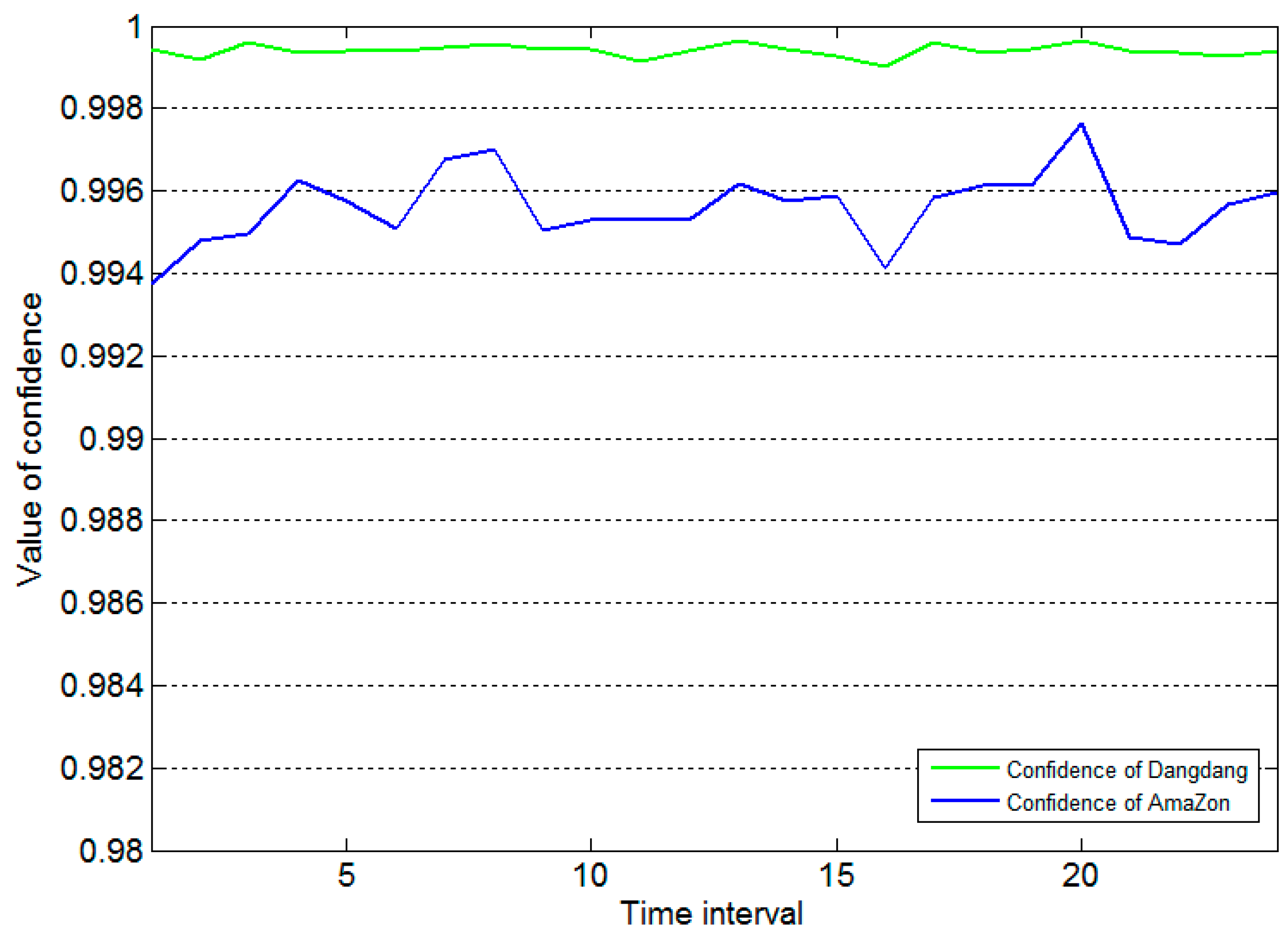
5.3. Discussion
6. Conclusions
Acknowledgments
Author Contributions
Conflicts of Interest
References
- China Internet Network Information Center. The Thirty-Fifth China Internet Network Development Status Report in February, 2015. Available online: https://www.cnnic.cn/hlwfzyj/hlwxzbg/hlwtjbg/201502/t20150203_51634.htm (accessed on 28 January 2016). (In Chinese)
- Lin, W.-S.; Wang, C.-H. Antecedences to continued intentions of adopting e-learning system in blended learning instruction: A contingency framework based on models of information system success and task-technology fit. Comput. Educ. 2012, 58, 88–99. [Google Scholar] [CrossRef]
- Wu, X.; Chen, Q.; Zhou, W.; Guo, J. A review of mobile commerce consumers’ behavior research: Consumer acceptance, loyalty and continuance (2000–2009). Int. J. Mob. Commun. 2010, 8, 528–560. [Google Scholar] [CrossRef]
- Pinyol, I.; Sabater-Mir, J. Computational trust and reputation models for open multi-agent systems: A review. Artif. Intell. Rev. 2013, 40, 1–25. [Google Scholar] [CrossRef]
- Gutowska, A.; Sloane, A.; Buckley, K.A. On Desideratum for B2C E-Commerce Reputation Systems. J. Comput. Sci. Technol. 2009, 24, 820–832. [Google Scholar] [CrossRef]
- Jøsang, A.; Ismail, R.; Boyd, C. A survey of trust and reputation systems for online service provision. Decis. Support Syst. 2007, 43, 618–644. [Google Scholar] [CrossRef]
- Wang, Y.D.; Emurian, H.H. An overview of online trust: Concepts, elements, and implications. Comput. Hum. Behav. 2005, 21, 105–125. [Google Scholar] [CrossRef]
- Qin, T.; Liu, X. DSRtrust: A dynamic trust model of distinguishing service and recommendation for internet-based virtual computing environment. Int. J. Grid Distrib. Comput. 2014, 7, 135–147. [Google Scholar] [CrossRef]
- Zhang, X.; Cui, L.; Wang, Y. Commtrust: Computing multi-dimensional trust by mining e-commerce feedback comments. IEEE Trans. Knowl. Data Eng. 2014, 26, 1631–1643. [Google Scholar] [CrossRef]
- Urbano, J.; Rocha, A.P.; Oliveira, E. An approach to computational social trust. AI Commun. 2014, 27, 113–131. [Google Scholar]
- Sabater, J.; Sierra, C. Review on computational trust and reputation models. Artif. Intell. Rev. 2005, 24, 33–60. [Google Scholar] [CrossRef]
- Kant, V.; Bharadwaj, K.K. Fuzzy computational models of trust and distrust for enhanced recommendations. Int. J. Intell. Syst. 2013, 28, 332–365. [Google Scholar] [CrossRef]
- Marsh, S.P. Formalizing Trust as a Computational Concept. Ph.D. Thesis, University of Stirling, Stirling, UK, 1994. [Google Scholar]
- Shankar, V.; Urban, G.L.; Sultan, F. Online trust: A stakeholder perspective, concepts, implications, and future directions. J. Strateg. Inf. Syst. 2002, 11, 325–344. [Google Scholar] [CrossRef]
- Che, S.; Feng, R.; Liang, X.; Wang, X. A lightweight trust management based on Bayesian and entropy for wireless sensor networks. Secur. Commun. Netw. 2015, 8, 168–175. [Google Scholar] [CrossRef]
- Shi, X.; Zhang, Y. Design and implementation of P2P trust model based on the classic Bayesian networks theory. J. Theor. Appl. Inf. Technol. 2012, 45, 129–135. [Google Scholar]
- Denko, M.K.; Sun, T.; Woungang, I. Trust management in ubiquitous computing: A Bayesian approach. Comput. Commun. 2011, 34, 398–406. [Google Scholar] [CrossRef]
- Zheng, Q.; Tian, B. A Trust Evaluation Model for B2C E-Commerce. In Proceedings of the 2007 IEEE International Conference on Service Operations and Logistics, and Informatics, Philadelphia, PA, USA, 27–29 August 2007.
- Tian, B.; Yang, L. Dynamic Reputation Model in Service-Oriented Computing Environment. In Proceedings of the 2011 International Conference on Transportation, Mechanical, and Electrical Engineering (TMEE), Changchun, China, 16–18 December 2011.
- Tian, B.; Wang, J.; Yang, L. Recommended trust evaluation in B2C E-commerce based on fuzzy analytic hierarchy process. Int. J. Knowl. Syst. Sci. 2012, 3. [Google Scholar] [CrossRef]
- Ramchurn, S.D.; Huynh, D.; Jennings, N.R. Trust in multi-agent systems. Knowl. Eng. Rev. 2004, 19. [Google Scholar] [CrossRef]
- Li, H.; Singhal, M. Trust management in distributed systems. IEEE Comput. 2007, 40, 45–53. [Google Scholar] [CrossRef]
- Alvaro, E.A.; Benjamin, A.; Gheorghe, C.S. Reputation management in collaborative computing systems. Secur. Commun. Netw. 2010, 3, 546–564. [Google Scholar]
- Srivatsa, M.; Liu, L. Securing decentralized reputation management using TrustGuard. J. Parallel Distrib. Comput. 2006, 66, 1217–1232. [Google Scholar] [CrossRef]
- Xiong, L.; Liu, L. PeerTrust: Supporting reputation-based trust for peer-to-peer electronic communities. IEEE Trans. Knowl. Data Eng. 2004, 16, 843–857. [Google Scholar] [CrossRef]
- Kraounakis, S.; Demetropoulos, I.N.; Michalas, A.; Obaidat, M.S.; Sarigiannidis, P.G.; Louta, M.D. A robust reputation-based computational model for trust establishment in pervasive systems. IEEE Syst. J. 2015, 9, 878–891. [Google Scholar] [CrossRef]
- Li, X.; Du, J. Adaptive and attribute-based trust model for service level agreement guarantee in cloud computing. IET Inf. Secur. 2013, 7, 39–50. [Google Scholar] [CrossRef]
- Mobile Commerce and Wireless Computing Systems (Chin. Transl.); Chen, Z.B., Translator; Higher Education Press: Beijing, China, 2006. Elliott, G.; Phillips, N. Addison-Wesley: Boston, MA, USA, 2003.
- Ponte, E.B.; Carvajal-Trujillo, E.; Escobar-Rodríguez, T. Influence of trust and perceived value on the intention to purchase travel online: Integrating the effects of assurance on trust antecedents. Tour. Manag. 2015, 47, 286–302. [Google Scholar] [CrossRef]
- Hong, I.B. Understanding the consumer’s online merchant selection process: The roles of product involvement, perceived risk, and trust expectation. Int. J. Inf. Manag. 2015, 35, 322–336. [Google Scholar] [CrossRef]
- Moody, G.D.; Galletta, D.F.; Lowry, P.B. When trust and distrust collide online: The engenderment and role of consumer ambivalence in online consumer behavior. Electron. Commer. Res. Appl. 2014, 13, 266–282. [Google Scholar] [CrossRef]
- Kim, K.; Hong, E.; Rho, S. The study of defined buying factors affecting trust building and service performance in financial management systems. Math. Comput. Model. 2013, 58, 38–48. [Google Scholar] [CrossRef]
- Yen, D.C.; Wu, C.S.; Cheng, F.F.; Huang, Y.W. Determinants of users’ intention to adopt wireless technology: An empirical study by integrating TTF with TAM. Comput. Hum. Behav. 2010, 26, 906–915. [Google Scholar] [CrossRef]
- Jøsang, A. The Right Type of Trust for Distributed Systems. In Proceedings of the 1996 Workshop on New Security Paradigms (NSPW ‘96), Lake Arrowhead, CA, USA, 17–20 September 1996.
- Yu, B.; Singh, M.P. An Evidential Model of Distributed Reputation Management. In Proceedings of the First International Joint Conference on Autonomous Agents and Multi-Agent Systems (AAMAS ‘02), Bologna, Italy, 15–19 July 2002.
- Sabater, J.; Sierra, C. REGRET: A Reputation Model for Gregarious Societies. In Proceedings of the fifth International Conference on Autonomous Agents (AGENTS ’01), Montreal, QC, Canada, 28 May–1 June 2001.
- Schmidt, S.; Steele, R.; Dillon, T.S.; Chang, E. Fuzzy trust evaluation and credibility development in multi-agent systems. Appl. Soft Comput. 2007, 7, 492–505. [Google Scholar] [CrossRef]
- Song, S.; Hwang, K.; Zhou, R.; Kwok, Y.K. Trusted P2P transactions with fuzzy reputation aggregation. IEEE Internet Comput. 2005, 9, 24–34. [Google Scholar] [CrossRef]
- Zhou, R.; Hwang, K.; Cai, M. GossipTrust for fast reputation aggregation in Peer-to-Peer networks. IEEE Trans. Knowl. Data Eng. 2008, 20, 1282–1295. [Google Scholar] [CrossRef]
- Wang, Y.; Lin, K.-J.; Wong, D.S.; Varadharajan, V. Trust management towards service-oriented applications. Serv. Oriented Comput. Appl. 2009, 3, 129–146. [Google Scholar] [CrossRef]
- Golbeck, J.; Hendler, J. Accuracy of Metrics for Inferring Trust and Reputation in Semantic Web-Based Social Networks. In Proceedings of the 14th International Conference on Knowledge Engineering and Knowledge Management, Northamptonshire, UK, 5–8 October 2004.
- Buragohain, C.; Agrawal, D.; Suri, S. A Game Theoretic Framework for Incentives in P2P Systems. In Proceedings of the Third International Conference on Peer-to-Peer Computing (P2P ’03), Linköping, Sweden, 1–3 September 2003.
- Cho, J.; Kwon, K.; Park, Y. Q-rater: A collaborative reputation system based on source credibility theory. Expert Syst. Appl. 2009, 36, 3751–3760. [Google Scholar] [CrossRef]
- Wang, Y.; Hang, C.W.; Singh, M.P. A probabilistic approach for maintaining trust based on evidence. J. Artif. Intell. Res. 2011, 40, 221–267. [Google Scholar]
- Liu, X.; Datta, A.; Rzadca, K. Trust beyond reputation: A computational trust model based on stereotypes. Electron. Commer. Res. Appl. 2013, 12, 24–39. [Google Scholar] [CrossRef]
- Despotovic, Z.; Aberer, K. Maximum Likelihood Estimation of Peers’ Performance in P2P Networks. Available online: http://www.eecs.harvard.edu/p2pecon/confman/papers/s2p3.pdf (accessed on 28 January 2016).
- Beth, T.; Borcherding, M.; Klein, B. Valuation of trust in open networks. In Proceedings of the Third European Symposium on Research in Computer Security, Brighton, UK, 7–9 November 1994.
- Ismai1, R.; Jøsang, A. The Beta Reputation System. In Proceedings of the 15th Bled Electronic Commerce Conference, Bled, Slovenia, 17–19 June 2002.
- Mui, L.; Mohtashemi, M.; Halberstadt, A. A Computational Model of Trust and Reputation. In Proceedings of the 35th Annual Hawaii International Conference on System Sciences, Big Island, HI, USA, 7–10 January 2002.
- Jøsang, A.; Haller, J. Dirichlet Reputation Systems. In Proceedings of the Second International Conference on Availability, Reliability and Security (ARES ’07), Vienna, Austria, 10–13 April 2007.
- Wang, Y.; Vassileva, J. Bayesian Network-Based Trust Model. In Proceedings of the IEEE/WIC International Conference on Web Intelligence (WI 2003), Halifax, NS, Canada, 13–17 October 2003.
- Teacy, W.L.; Luck, M.; Rogers, A.; Jennings, N.R. An efficient and versatile approach to trust and reputation using hierarchical Bayesian modeling. Artif. Intell. 2012, 193, 149–185. [Google Scholar] [CrossRef]
- Kim, D.J.; Song, Y.I.; Braynov, S.B.; Rao, H.R. A multidimensional trust formation model in B-to-C e-commerce: A conceptual framework and content analyses of academia practitioner perspectives. Decis. Support Syst. 2005, 40, 143–165. [Google Scholar] [CrossRef]
- Mayer, R.C.; Davis, J.H.; Schoorman, F.D. An integrative model of organizational trust. Acad. Manag. Rev. 1995, 20, 709–734. [Google Scholar]
- Tian, B.; Zheng, Q. Recommended Trust Evaluation Model in Business-to-Consumer E-Commerce Based on DS Evidence Fusion Theory. J. Manag. Sci. 2008, 21, 98–104. [Google Scholar]
- McKnight, D.H.; Choudhury, V.; Kacmar, C. Developing and validating trust measures for e-commerce: An integrative typology. Inf. Syst. Res. 2002, 13, 334–359. [Google Scholar] [CrossRef]
- Tian, B.; Liu, K.C.; Chen, Y.Z. Dynamical Trust and Reputation Computation Model for B2C E-Commerce. Future Internet 2015, 7, 405–428. [Google Scholar] [CrossRef]
- Thirunarayan, K.; Anantharam, P.; Henson, C.; Sheth, A. Comparative trust management with applications: Bayesian approaches emphasis. Future Gener. Comput. Syst. 2014, 31, 182–199. [Google Scholar] [CrossRef] [Green Version]
- Kravari, K.; Bassiliades, N. HARM: A Hybrid Rule-Based Agent Reputation Model Based on Temporal Defensible Logic. In Proceedings of the 6th International Symposium on Rules: Research Based and Industry Focused, Montpellier, France, 27–29 August 2012.
© 2016 by the authors; licensee MDPI, Basel, Switzerland. This article is an open access article distributed under the terms and conditions of the Creative Commons by Attribution (CC-BY) license (http://creativecommons.org/licenses/by/4.0/).
Share and Cite
Tian, B.; Han, J.; Liu, K. Closed-Loop Feedback Computation Model of Dynamical Reputation Based on the Local Trust Evaluation in Business-to-Consumer E-Commerce. Information 2016, 7, 4. https://doi.org/10.3390/info7010004
Tian B, Han J, Liu K. Closed-Loop Feedback Computation Model of Dynamical Reputation Based on the Local Trust Evaluation in Business-to-Consumer E-Commerce. Information. 2016; 7(1):4. https://doi.org/10.3390/info7010004
Chicago/Turabian StyleTian, Bo, Jingti Han, and Kecheng Liu. 2016. "Closed-Loop Feedback Computation Model of Dynamical Reputation Based on the Local Trust Evaluation in Business-to-Consumer E-Commerce" Information 7, no. 1: 4. https://doi.org/10.3390/info7010004
APA StyleTian, B., Han, J., & Liu, K. (2016). Closed-Loop Feedback Computation Model of Dynamical Reputation Based on the Local Trust Evaluation in Business-to-Consumer E-Commerce. Information, 7(1), 4. https://doi.org/10.3390/info7010004





